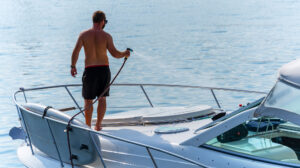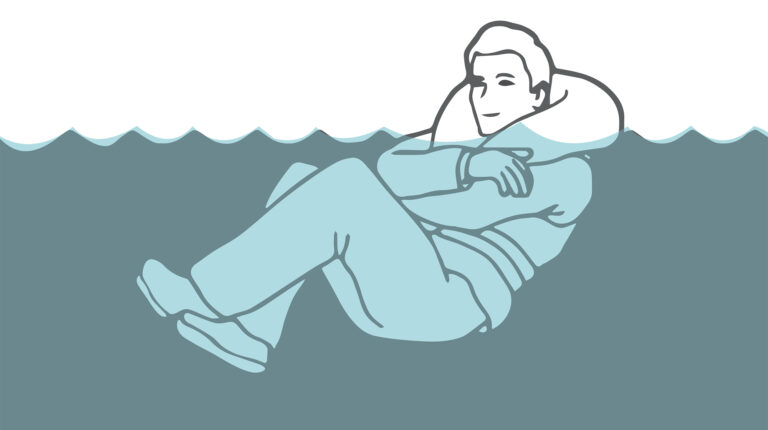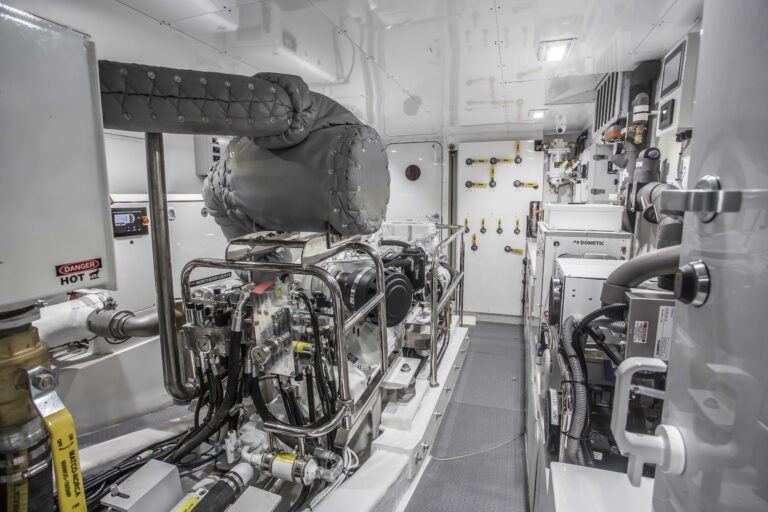
Who doesn’t like a nice, cool drink on a hot summer afternoon, especially while lazing in the cockpit, catching rays, and feeling the tickle of the sea breeze? The tinkle of cubes in the glass (probably plastic, but still), the sweat of condensation on an icy can, the fizz of cold carbonation in a parched throat: These are all joys of summer, and of boating. But without a convenient source of cold—a nearby cooler, mini-fridge, or even a bucket of ice—these joys will be less enjoyable, disturbed by the occasional need to mosey into the galley to fetch another cold one. Who needs that? You could twist an ankle on the companionway steps! Instead, make your boat safer and more lounge-friendly by adding cockpit refrigeration. It’s easier than you think.

Maybe you already have a refrigerator on deck, or at least a place to put one: Cockpit wet bars are common aboard express cruisers, big bowriders, and other dayboats. A basic setup has a sink, a working surface, and either an icebox stowed in its own locker, or an under-counter electric refrigerator. The reefer is usually an option, but the furniture is standard (and maybe the wiring for the optional reefer is too), so adding a refrigerator means simply finding one that fits. The boatbuilder can tell you what model was intended for the space; buy it, install it, and start enjoying cold food and drink without making the onerous journey belowdecks. Case closed. We should all be so lucky.
Truth is, most of us don’t have a refrigerator-ready locker waiting to be filled. We need to use a bit of creativity to find an empty space in the cockpit that’s large enough and ventilated enough for a refrigerator. Compressors give off heat, and there has to be sufficient airflow to carry the heat away; otherwise, the reefer is going to be unhappy and less efficient. Even a small-ish refrigerator takes up a lot of space. Building a console to hold one doesn’t make sense—might as well buy another boat with a full-up wet bar. But chances are there’s space somewhere that can be hijacked to hold a small reefer, one that’ll fit in a drawer.

Sliding Ice
Dometic (dometic.com), Isotherm (indelwebastomarine.com), and Vitrifrigo (vitrifrigo.com) build drawer-style refrigerators that offer roughly 1 cubic foot of volume. They’re made to slide into the space under a settee or seat—the fiberglass riser under many helm and/or companion seats is ideal for a drawer-style reefer. Like many marine refrigerators, the best drawer fridges use an energy-efficient compressor (Danfoss is the name to look for); run off 12-volt, 24-volt, or (with an adapter) 120-volt power; and draw around four amps at 12 volts. With 1.3 cubic feet (9.6 gallons) of volume, the Isotherm Cruise 36, a typical drawer-style refrigerator, will fit in a cutout that’s 18 inches wide by 10 inches high, and requires a depth of 28 3/16 inches. However, the depth requirement can be reduced by 6 inches by moving the compressor from the back to the side of the box, or mounting it remotely within a few feet of the box. These drawer refrigerators aren’t huge, but they’ll hold enough bottles of water, 12-ounce cans, and sandwiches to get you through an arduous afternoon of total relaxation.
The trickiest part of installing a drawer refrigerator is securing it in place; if it’s going into an existing locker, for instance, the cutout will never be the right size—too small is easy, too large means fabricating a filler of some kind. Otherwise, the unit is self-contained and requires only wiring, at least in theory. But if the compressor has to be moved, that makes the install job more complex. If the drawer space has no ventilation, a hole, or maybe two, will need to be cut, and finished with a louver or clamshell; and the wiring should be done to ABYC standards. So bottom line, I recommend hiring the yard, or a qualified marine electrician, to do the installation. And these things aren’t cheap to start with: The Isotherm Cruise 36 mentioned above lists for more than $1,000; a comparable Dometic CD-030 runs about $800. Add the installation, and you’re looking at some real money.

How Much Juice?
When the engine’s running or the shore cord’s plugged in, who cares how much electricity the reefer needs to stay cold? The alternator or charger takes care of that. But when swinging at anchor for any length of time, running off the batteries, power usage is more critical. Nothing sucks up amps like a 12-volt refrigerator with a compressor that’s working overtime. But how much power does a reefer really need?
Experts estimate a marine refrigerator’s compressor typically runs about 40 percent of the time. I think 50 percent’s a better estimate on a hot summer day with people opening the door repeatedly, and it’s safer to over-estimate power drain, anyway. Consult the manual for your reefer to discover how much power it uses; some manufacturers specify watts, so divide by voltage to get amps. (Most 12-volt refrigerators draw between four and six amps.) Four hours at anchor with the engine shut down means two hours of compressor operation, and a battery drain of 12 amps or so, over and above the baseline drain. Anchor overnight, say for 12 hours, and you’ll use roughly 36 amps. At any rate, keeping an eye on battery voltage will head off power issues before they become overly dramatic, and always switch to one bank of batteries when there’s no recharging taking place. That way you’ll have plenty of juice left to fire up the engines when you need to go ashore for more refreshments.
Carry Your Cool
The older I get, the less complex I want things to be, so rather than install a permanent refrigerator, I might go with a portable electric cooler, one that operates off both 120 volts and 12 volts, switches between voltages automatically, can refrigerate and freeze (some models can do both at the same time), and can be taken home and stored at the end of the season—or after every trip, if you prefer. A portable cooler still isn’t cheap—figure on spending several hundred bucks for a good one, but that’s about it. Installation cost? Zero, unless you don’t already have a 12-volt cigarette-lighter-type plug in your cockpit. Maintenance cost? Zero, unless you factor in the price of the soap you use for periodic cleanings.
Portable coolers, by the way, come in sizes from too heavy to carry easily, to small enough to sling over your shoulder. If you have an ice chest on board, there’s a portable cooler that will fit in its place; if you want a miniature box to keep near the helm, there’s one for that too. Most refrigerator manufacturers sell portables; the Norcold NRF 30 refrigerator/freezer (thetford.com) is a typical full-featured smaller (8-gallon) model, with an electronic control panel, a stainless-steel interior, and user-adjustable battery protection. It weighs 40 pounds empty and draws about 4 amps at 12 volts. Cost? About $600. Dometic and Isotherm sell similar products.
Ice Is Nice
And finally, consider this. Mechanical refrigeration is cool, but what’s wrong with ice? Most people don’t spend weeks, or even days, on board. If your cruising time tends to be limited, why hassle with electric refrigeration, especially when there’s probably a reefer in the galley anyway? Put food that has to be kept cold and dry there, but dump snacks and drinks for the on-deck crew in an ice chest. A good Igloo (igloocoolers.com) or Yeti (yeti.com) will do the trick, even in the summer, with the added advantage of a supply of ice cubes for drinks. I’m an Igloo man myself, but Yeti ice chests supposedly have the advantage of being bear-proof, which I’m told can come in handy at times. For non-boaters, of course.
For more tips like this, visit the Passagemaker Pro Tips Archive
Story appears courtesy of our sister publication, Power & Motoryacht.











